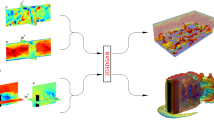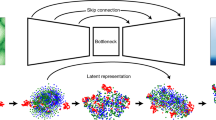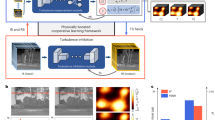Abstract
A turbulent medium with eddies of different scales gives rise to fluctuations in the index of refraction during the process of wave propagation, which interferes with the original spatial relationship, phase relationship and optical path. The outputs of two-dimensional imaging systems suffer from anamorphosis brought about by this effect. Randomness, along with multiple types of degradation, make it a challenging task to analyse the reciprocal physical process. Here, we present a generative adversarial network (TSR-WGAN), which integrates temporal and spatial information embedded in the three-dimensional input to learn the representation of the residual between the observed and latent ideal data. Vision-friendly and credible sequences are produced without extra assumptions on the scale and strength of turbulence. The capability of TSR-WGAN is demonstrated through tests on our dataset, which contains 27,458 sequences with 411,870 frames of algorithm simulated data, physical simulated data and real data. TSR-WGAN exhibits promising visual quality and a deep understanding of the disparity between random perturbations and object movements. These preliminary results also shed light on the potential of deep learning to parse stochastic physical processes from particular perspectives and to solve complicated image reconstruction problems given limited data.
This is a preview of subscription content, access via your institution
Access options
Access Nature and 54 other Nature Portfolio journals
Get Nature+, our best-value online-access subscription
$29.99 / 30 days
cancel any time
Subscribe to this journal
Receive 12 digital issues and online access to articles
$119.00 per year
only $9.92 per issue
Buy this article
- Purchase on Springer Link
- Instant access to full article PDF
Prices may be subject to local taxes which are calculated during checkout






Similar content being viewed by others
Data availability
The full datasets, including the algorithm simulated data, physical simulated data and real-world data presented in this Article are publicly available in the Zenodo repository at https://doi.org/10.5281/zenodo.510191051.
Code availability
The code presented in this Article is available through a Code Ocean compute capsule (10.24433/CO.3517894.v1)52, together with a subset of data to test the network.
References
Xia, Z. H. Multiple states in turbulence. Chin. Sci. Bull. 64, 373–383 (2019).
Wyngaard, J. C. Atmospheric turbulence. Annu. Rev. Fluid Mech. 24, 205–234 (1992).
Lohse, D. & Xia, K. Q. Small-scale properties of turbulent Rayleigh–Bénard convection. Annu. Rev. Fluid Mech. 42, 335–364 (2010).
Xi, H. D. & Xia, K. Q. Flow mode transitions in turbulent thermal convection. Phys. Fluids 20, 055104 (2008).
Zhu, X. & Milanfar, P. Removing atmospheric turbulence via space-invariant deconvolution. IEEE Trans. Pattern Anal. Mach. Intell. 35, 157–170 (2013).
Wu, C. S., Ko, J. & Davis, C. C. Imaging through strong turbulence with a light field approach. Opt. Express 24, 11975–11986 (2016).
Rigaut, F. & Neichel, B. Multiconjugate adaptive optics for astronomy. Annu. Rev. Astron. Astr. 56, 277–314 (2018).
Hope, D. A., Jefferies, S. M., Hart, M. & Nagy, J. G. High-resolution speckle imaging through strong atmospheric turbulence. Opt. Express 24, 12116–12129 (2016).
Law, N. M., Mackay, C. D. & Baldwin, J. Lucky imaging: high angular resolution imaging in the visible from the ground. Astron. Astrophys. 446, 739–745 (2006).
Anantrasirichai, N., Achim, A., Kingsbury, N. G. & Bull, D. R. Atmospheric turbulence mitigation using complex wavelet-based fusion. IEEE Trans. Image Process. 22, 2398–2408 (2013).
Hirsch, M., Sra, S., Schölkopf, B. & Harmeling, S. Efficient filter flow for space-variant multiframe blind deconvolution. In Proc. IEEE Conference on Computer Vision and Pattern Recognition 607–614 (IEEE, 2010).
Xie, Y. et al. Removing turbulence effect via hybrid total variation and deformation-guided kernel regression. IEEE Trans. Image Process. 25, 4943–4958 (2016).
Oreifej, O., Li, X. & Shah, M. Simultaneous video stabilization and moving object detection in turbulence. IEEE Trans. Pattern Anal. Mach. Intell. 35, 450–462 (2013).
Halder, K. K., Tahtali, M. & Anavatti, G. Geometric correction of atmospheric turbulence-degraded video containing moving objects. Opt. Express 23, 5091–5101 (2015).
Iqbal, A., Khan, R. & Karayannis, T. Developing brain atlas through deep learning. Nat. Mach. Intell. 1, 277–287 (2019).
Tolkach, Y., Dohmgörgen, T., Toma, M. & Kristiansen, G. High-accuracy prostate cancer pathology using deep learning. Nat. Mach. Intell. 2, 411–418 (2020).
Richards, B. A. & Lillicrao, T. P. et al. A deep learning framework for neuroscience. Nat. Neurosci. 22, 1761–1770 (2019).
Baldi, P., Sadowski, P. & Whiteson, D. Searching for exotic particles in high-energy physics with deep learning. Nat. Commun. 5, 4308 (2014).
Pang, L. et al. An equation-of-state-meter of quantum chromodynamics transition from deep learning. Nat. Commun. 9, 210 (2018).
LeCun, Y., Bengio, Y. & Hinton, G. Deep learning. Nature 521, 436–444 (2015).
Dai, T., Cai, J., Zhang, Y., Xia, S. & Zhang, L. Second-order attention network for single image super-resolution. In Proc. IEEE Conference on Computer Vision and Pattern Recognition 11065–11074 (IEEE, 2019).
Yu, J. H. et al. Free-form image inpainting with gated convolution. In Proc. IEEE International Conference on Computer Vision 4471–4480 (2019).
Fried, D. L. Optical resolution through a randomly inhomogeneous medium for very long and very short exposures. J. Opt. Soc. Am. 56, 1372–1379 (1966).
Wang, Z., Bovik, A. C., Sheikh, H. R. & Simoncelli, E. P. Image quality assessment: from error visibility to structural similarity. IEEE Trans. Image Process. 13, 600–612 (2004).
Xue, W., Zhang, L., Mou, X. & Bovik, A. C. Gradient magnitude similarity deviation: a highly efficient perceptual image quality index. IEEE Trans. Image Process. 23, 684–695 (2014).
Zhang, L., Zhang, L., Mou, X. & Zhang, D. FSIM: a feature similarity index for image quality assessment. IEEE Trans. Image Process. 20, 2378–2386 (2011).
Zhang, L., Shen, Y. & Lee, H. VSI: a visual saliency-induced index for perceptual image quality assessment. IEEE Trans. Image Process. 23, 4270–4281 (2014).
Soundararajan, R. & Bovik, A. C. Video quality assessment by reduced reference spatio-temporal entropic differencing. IEEE Trans. Circuits Syst. Video Techn. 23, 684–694 (2013).
Bradley, R. A. & Terry, M. E. Rank analysis of incomplete block designs: I. The method of paired comparisons. Biometrika 39, 324–345 (1952).
Xue, B. D. et al. Video stabilization in atmosphere turbulent conditions based on the Laplacian–Riesz pyramid. Opt. Express 24, 28092–29103 (2016).
Lou, Y. F., Kang, S. H., Soatto, S. & Bertozzi, A. L. Video stabilization of atmospheric turbulence distortion. Inverse Probl. Imag. 7, 839–861 (2013).
Chan, S. H., Khoshabeh, R., Gibson, K. B., Gill, P. E. & Nguyen, T. Q. An augmented Lagrangian method for total variation video restoration. IEEE Trans. Image Process. 20, 3097–3111 (2011).
Su, S. C. et al. Deep video deblurring for hand-held cameras. In Proc. IEEE Conference on Computer Vision and Pattern Recognition 1279–1288 (IEEE, 2017).
Kupyn, O., Martyniuk, T., Wu, J. & Wang, Z. Y. DeblurGAN-v2: deblurring (orders-of-magnitude) faster and better. In Proc. IEEE International Conference on Computer Vision 8878–8887 (IEEE, 2019).
Zhang, K. H. et al. Adversarial spatio-temporal learning for video deblurring. IEEE Trans. Image Process. 28, 291–301 (2019).
Kim, T. H., Lee, K. M., Scholkopf, B. & Hirsch, M. Online video deblurring via dynamic temporal blending network. In Proc. IEEE International Conference on Computer Vision 4038–4047 (IEEE, 2017).
Pan, J. S., Bai, H. R. & Tang, J. H. Cascaded deep video deblurring using temporal sharpness prior. In Proc. IEEE Conference on Computer Vision and Pattern Recognition 3043–3051 (IEEE, 2020).
Xiang, X. G., Wei, H. & Pan, J. S. Deep video deblurring using sharpness features from exemplars. IEEE Trans. Image Process. 29, 8976–8987 (2020).
Repasi, E. & Weiss, R. Analysis of image distortions by atmospheric turbulence and computer simulation of turbulence effects. In Proc. SPIE, Infrared Imaging Systems: Design, Analysis, Modeling and Testing XIX Vol. 6941, 1–13 (SPIE, 2008).
Arbeláez, P., Maire, M., Fowlkes, C. & Malik, J. Contour detection and hierarchical image segmentation. IEEE Trans. Pattern Anal. Mach. Intell. 33, 898–916 (2011).
Soomro, K., Zamir, A. R. & Shah, M. UCF101: a dataset of 101 human actions classes from videos in the wild. Preprint at https://arxiv.org/pdf/1212.0402.pdf (2012).
Smith, F. G. (ed.) The Infrared & Electro-Optical Systems Handbook Vol. 2 (SPIE, 1996).
Badrinarayanan, V., Kendall, A. & Cipolla, R. SegNet: a deep convolutional encoder–decoder architecture for image segmentation. IEEE Trans. Pattern Anal. Mach. Intell. 39, 2481–2495 (2017).
Kupyn, O., Budzan, V., Mykhailych, M., Mishkin, D. & Matas, J. DeblurGAN: blind motion deblurring using conditional adversarial networks. In Proc. IEEE Conference on Computer Vision and Pattern Recognition 8183–8192 (IEEE, 2018).
He, K. M., Zhang, X. Y., Ren, S. Q. & Sun, J. Deep residual learning for image recognition. In Proc. IEEE Conference on Computer Vision and Pattern Recognition 770–778 (IEEE, 2016).
Isola, P., Zhu, J. Y., Zhou, T. H. & Efros, A. A. Image-to-image translation with conditional adversarial networks. In Proc. IEEE Conference on Computer Vision and Pattern Recognition 1125–1134 (IEEE, 2017).
Zhu, J. Y., Park, T., Isola, P. & Efros, A. A. Unpaired image-to-image translation using cycle-consistent adversarial networks. In Proc. IEEE International Conference on Computer Vision 2223–2232 (IEEE, 2017).
Johnson, J., Alahi, A. & Li, F. F. Perceptual losses for real-time style transfer and super-resolution. In Proc. European Conference on Computer Vision 694–711 (Springer, 2016).
Gulrajani, I., Ahmed, F., Arjovsky, M., Dumoulin, V. & Courville, A. Improved training of Wasserstein GANs. In Proc. Annual Conference on Neural Information Processing Systems 694–711 (NIPS, 2017).
Paszke, A. et al. PyTorch: an imperative style, high-performance deep learning library. In Proc. Annual Conference on Neural Information Processing Systems 8024–8035 (NIPS, 2019).
Jin, D. R. et al. Atmospheric turbulence distorted video sequence dataset. Zenodo https://doi.org/10.5281/zenodo.5101910 (2021).
Jin, D. R. et al. Temporal-spatial residual perceiving Wasserstein GAN for turbulence distorted sequence restoration (TSR-WGAN) (CodeOcean, 2021); https://codeocean.com/capsule/9958894/tree/v1
Acknowledgements
This work was supported by grants from the National Natural Science Foundation of China (no. U1736217) and partly by grants from the National Key Research and Development Program of China (no. 2019YFB1311301).
Author information
Authors and Affiliations
Contributions
D.J. and X.B. conceived the idea and were responsible for the methodology. D.J., Y.C., Y.L., Z.L. and S.G. performed the experiments and created the dataset. D.J. and J.C. developed the software and designed the subjective evaluation. Y.C. and P.W. participated in the model design. X.B. supervised the project. D.J. and X.B. wrote the manuscript.
Corresponding author
Ethics declarations
Competing interests
The authors declare no competing interests.
Additional information
Peer review information Nature Machine Intelligence thanks Soumik Sarkar and the other, anonymous, reviewer(s) for their contribution to the peer review of this work.
Publisher’s note Springer Nature remains neutral with regard to jurisdictional claims in published maps and institutional affiliations.
Supplementary information
Supplementary Information
Supplementary Figs. 1–13 and Tables 1–4.
Supplementary Video 1
Dynamic results of algorithm simulated data.
Supplementary Video 2
Dynamic results of algorithm simulated data.
Supplementary Video 3
Dynamic results of algorithm simulated data.
Supplementary Video 4
Dynamic results of physical simulated data.
Supplementary Video 5
Dynamic results of physical simulated data.
Supplementary Video 6
Dynamic results of physical simulated data.
Supplementary Video 7
Dynamic results of real-world data.
Supplementary Video 8
Dynamic results of real-world data.
Supplementary Video 9
Dynamic results of real-world data.
Rights and permissions
About this article
Cite this article
Jin, D., Chen, Y., Lu, Y. et al. Neutralizing the impact of atmospheric turbulence on complex scene imaging via deep learning. Nat Mach Intell 3, 876–884 (2021). https://doi.org/10.1038/s42256-021-00392-1
Received:
Accepted:
Published:
Issue Date:
DOI: https://doi.org/10.1038/s42256-021-00392-1
This article is cited by
-
A Neural Network Method for Inversion of Turbulence Strength
Journal of Nonlinear Mathematical Physics (2024)
-
Revelation of hidden 2D atmospheric turbulence strength fields from turbulence effects in infrared imaging
Nature Computational Science (2023)
-
An imaging-based approach to measure atmospheric turbulence
Nature Computational Science (2023)



